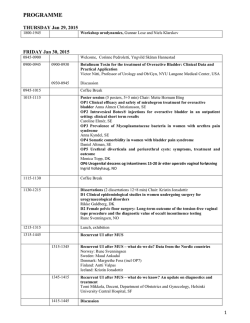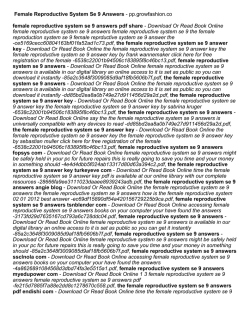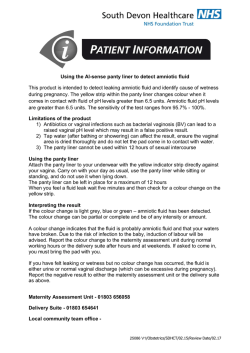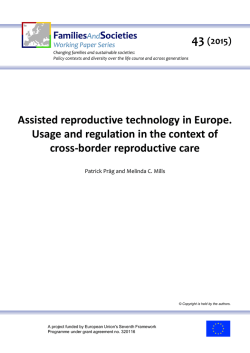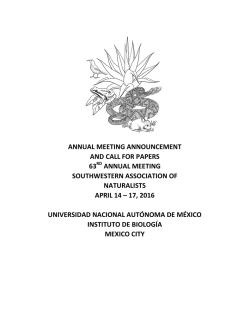
Vaginal smears: a key source of information on the estrous cycle of
Mastozoología Neotropical, 23(1):139-145, Mendoza, 2016 Versión impresa ISSN 0327-9383 Versión on-line ISSN 1666-0536 Copyright ©SAREM, 2016 http://www.sarem.org.ar http://www.sbmz.com.br Artículo Vaginal smears: A key source of information on the estrous cycle of Neotropical bats I. Mauricio Vela-Vargas1,2, Laura Pérez-Pabón2, Paloma Larraín2, and Jairo Pérez-Torres2 Proyecto de Conservación de Aguas y Tierras – ProCAT Colombia. Carrera 13 No. 96-82, Oficina 205. Bogotá, Colombia [Correspondence: I. Mauricio Vela-Vargas <[email protected]>] 2 Laboratorio de Ecología Funcional, Unidad de Ecología y Sistemática (UNESIS), Departamento de Biología, Pontificia Universidad Javeriana. Bogotá, Colombia. 1 ABSTRACT. The use of vaginal smears for the study of the reproductive patterns of Neotropical bats has not been employed using a standardized protocol. We developed and evaluated a protocol, based on this technique, for the identification of the estrous cycle in an assemblage of bats in the Caribbean region of Colombia. The protocol for vaginal smears in bats was performed in three phases: 1) sampling in the field, 2) staining of vaginal smears, and 3) vaginal cell counts. Vaginal smears were taken and external reproductive characteristics were determined in the field. The results of these two data sets were compared for estimation of estrous status. Significant differences were detected between the proportions of different types of vaginal cells found in the smear samples. Overall, 95% of the females characterized as reproductively inactive based on external traits were found to be reproductively active according to vaginal smear characteristics; the remaining percentage of inactive reproductive cases coincided with the information obtained from vaginal smear technique. The use of the vaginal smear protocol allows the accurate determination and quantification of the reproductive status of individuals and populations of Neotropical bats. We conclude that this protocol offers a standardized method for the collection of individual reproductive status information in Neotropical bats. RESUMEN. Citologías vaginales: una fuente clave de información del ciclo estral en murciélagos neotropicales. El uso de citologías vaginales para el estudio de los fenómenos reproductivos de los murciélagos neotropicales no ha sido implementado bajo un protocolo estandarizado. Evaluamos e implementamos un protocolo de citologías vaginales, con el objetivo de probar su eficacia para la identificación del ciclo estral de un ensamblaje de murciélagos en el Caribe colombiano. El protocolo para realizar citologías vaginales en murciélagos neotropicales se dividió en tres fases: 1) toma de muestras en campo, 2) coloración de citologías vaginales y 3) conteo de células vaginales. La prueba se realizó bajo condiciones de campo, registrando los caracteres externos reproductivos tradicionales, los cuales se confrontaron con los resultados de las citologías vaginales. Se encontraron diferencias significativas entre la proporción de los diferentes tipos de células contadas en las láminas de las citologías vaginales. El 95% de las hembras caracterizadas como inactivas mediante el registro de caracteres externos se encontraban en algún estado reproductivo de acuerdo a las citologías vaginales; el porcentaje restante de hembras caracterizadas como inactivas también presentó inactividad reproductiva según las citologías vaginales. El uso de este nuevo protocolo de caracterización reproductiva permite describir y cuantificar con Recibido 21 diciembre 2015. Aceptado 13 abril 2016. Editor asociado: G Francescoli 140 Mastozoología Neotropical, 23(1):139-145, Mendoza, 2016 http://www.sarem.org.ar - http://www.sbmz.com.br IM Vela-Vargas et al. mayor exactitud la actividad reproductiva, tanto individual como poblacional, de los murciélagos neotropicales. Por otra parte, sugiere una manera de estandarizar la toma de datos reproductivos a futuro. Key words: Chiroptera. Oestral cycle. Protocol. Reproductive evaluation. Vaginal smear. Palabras clave: Chiroptera. Ciclo estral. Citología vaginal. Evaluación reproductiva. Protocolo. INTRODUCTION Estrous cycles in Neotropical bats occur yearround (Racey, 2009; Altringham, 2011), and are generally associated with local flowering and fruiting events (Racey, 1982; Kunz et al., 2009). In tropical ecosystems, bat reproductive events involve different strategies depending on climatic variables such as rainfall and its effect on the availability of nutritional resources (Estrada and Coates-Estrada, 2001); whereas in temperate areas reproduction tends to be seasonal due to climatic restrictions (Willig, 1985; Barclay et al., 2004). Although environmental conditions, in general, are more stable in the tropics (Altringham, 2011), seasonally dependent changes in the abundance of fruits, flowers, and insects are usually contingent on levels of precipitation (Montiel et al., 2011), which trigger the reproductive activity of many tropical species (Wilson, 1979; Porter and Wilkinson, 2001; Sperr et al., 2011). The ecology of bat species and specifically reproduction-related traits have received considerable attention due to the diversity, heterogeneity, and functional importance of Neotropical bats across a diversity of tropical ecosystems. As such, accurate and low-cost methods are likely to prove of great value in understanding key aspects of the reproductive ecology of Neotropical bats and the impact of habitat fragmentation on their reproductive cycles. Studies on bat reproductive cycles, including determination of reproductive peaks, inactive periods, and female reproductive stages are often based on assessments of an individual’s reproductive stage and posterior association with environmental determinants (Fleming et al., 1972; Wilson, 1979; Costa et al., 2007; Duarte and Talamoni, 2010; SantosMoreno et al., 2010; Montiel et al., 2011). For this, the reproductive characterization of each individual is usually based on a set of external reproductive signs (Fleming et al., 1972; Dinerstein, 1986; Mena and Williams de Castro, 2002; Tschapka, 2005; Costa et al., 2007; Duarte and Talamoni, 2010). However, the fidelity, quality, and objectivity of data collection using this approach largely depend on the experience of the researcher in assessing each species and therefore the chances of subjective or inaccurate assessment are considerable. To mitigate potential inaccuracies, some authors have proposed the use of cytological smears of vaginal wall cells as a more accurate and objective method for estimating the reproductive stage of adult bats (Laska, 1990; Elizalde-Arellano et al., 2008; Wang et al., 2008; Racey, 2009). This method is based on the identification of the estrous cycle as a sequence of stages (anestrus, proestrus, estrus, and metaestrus), by counting and characterizing the different types of vaginal cells present in the vaginal wall (Racey, 2009). Each stage during the cycle has a singular and differential cell composition involving different proportions of parabasal, intermediate, and superficial nucleated or anucleated cells. This allows to determine estrous cycle stages, estimated through vaginal wall cell type counts (Nelson, 2000; Felipe et al., 2001; Touma et al., 2001; Escobar Botero et al., 2004; Ji et al., 2008). The objective of our study was to design and test a new protocol using vaginal smears technique for reproductive characterizations in Neotropical bats. 141 VAGINAL SMEARS IN NEOTROPICAL BATS MATERIALS AND METHODS Stage 3. Cell count Sampling was performed on small living female bats (Microchiroptera), in the field or under laboratory conditions, at all stages of the reproductive cycle. The protocol was divided into three stages from field collection to laboratory analysis: For the description of the different cellular types, the combination and proportions of cells and the stages of the estrous cycle, cell counting can be performed both under laboratory and/or field conditions. For this, cells are counted through phase contrast microscope with 40x magnification. Each microscope slide is divided into four sections and at least 50 cells are counted in each section. A minimum of 200 cells must be counted in each sample in order to accurately estimate the proportion for each cell type. The number of cells of each type (parabasal, intermediate, nucleated, and non-nucleated superficial) present in each sample is recorded (Nelson, 2000; Escobar Botero et al., 2004), and the percentage of each cell type is calculated per sample. Based on the observed cell-type proportions it is possible to determine female reproductive status. Stage 1. Vaginal mucosa cell sampling This method represents a low cost approach, in which samples are relatively easy to collect and analyze, and can provide useful information with relatively little sampling effort in the field. The step-by-step process is described below. A drop of sterile water (pH 5) solution was taken using a micropipette Socorex ® (0.1 - 2 μl) with tips Brand ® (0.1-20 μl). The standard measure for adult females of large species with a weight of more than 40 g was 2 μl (e.g. Phyllostomus spp., Artibeus spp., Noctilio spp.). In the case of juvenile females and small species with a weight of less than 40 g (e.g. Thyroptera spp., Myotis spp., Lasiurus spp., Dermanura spp., Glossophaga spp.) the micropipette must be set to a volume of 1.5 µl. The saline solution was introduced into the female’s vagina by inserting a short length of the micropipette tip to avoid harming the individual. Wait from five to ten seconds to obtain a suspension of the vaginal mucosa cells. Aspirate the saline solution from the vagina in the same way using the micropipette tip and transfer the suspension to a microscope slide. To transfer the suspension of saline onto the microscope slide, an S motion was used while expelling the suspension on the center of the slide. The sample was allowed to dry at ambient temperature for five to ten minutes inside a slide box to avoid dust contamination The sample was covered with a methanol (90%) spray in order to fix it, and the alcohol was allowed to evaporate completely. The slide was labeled and storaged in a box. Humidity during sample preparation in the field in humid tropical regions should be minimized using high-performance desiccants (e.g. Silica gel). Use of latex-gloves and a facemask when handling samples in the field and the laboratory help avoid sample contamination. Stage 2. Sample staining In this study we used Gram-stain technique because it’s simplicity, low cost and allows the observation of the relationships between nucleus and cytoplasm (Public Health England, 2015). Field test of the protocol We tested the protocol under field conditions in order to estimate its accuracy, feasibility, and agreement with traditional external traits assessment. Vaginal smears were obtained from females caught in the Department of Córdoba, northeastern Colombia, in August 2011 to March 2012. The specific study areas were located in the municipalities of Buena Vista (N.08°11’05.3’’; W.75°31’49.2’’), Canalete (N.08’30’37.1’’; W.76°06’12.9’’), Montería (N.08°44’32.4’’; W.76°19’23.4’’), and Los Córdoba (N.08°53’20.0’’;W.76°18’42.6’’). These areas are characterized by agricultural and livestock land-use, low human population density with fragments of tropical dry forest. For the manipulation of the individuals we followed all the recommendations American Society of Mammalogist (Sikes et al., 2011). The external reproductive status of each captured female was recorded (status of nipples, pregnancy, and lactancy) (Racey, 2009; Duarte and Talamoni, 2010; Santos-Moreno et al., 2010; Montiel et al., 2011). The laboratory steps, including Gram staining and cell type counting using a Nikon e400 microscope, were performed in the Laboratorio de Ecología Funcional of the Pontificia Universidad Javeriana, Bogotá, Colombia. Data analysis All analyses were performed using pooled results from all bat species sampled. Two sources of information on reproductive variables were evaluated: vaginal smears and external reproductive traits. The normality of the data set and comparative analyses 142 Mastozoología Neotropical, 23(1):139-145, Mendoza, 2016 http://www.sarem.org.ar - http://www.sbmz.com.br (Kruskal-Wallis test) were performed using InfoStat software (Di Rienzo et al., 2015). RESULTS Traits of epithelial cells were characterized in the counting of vaginal smears, parabasal cell are circular or oval, the nucleus covers a large proportion of the cytoplasm (Fig. 1a), in the anestrous stage the parabasal cells were more prevalent than the other cell types (H: 107.68, p 0.0001). Intermediate cells have polyhedral forms and large area of cytoplasm, the presence of granular chromatin in these type of cells recorded in the small and granulated nucleus (Figure 1b), the proportion of these cells was the highest in the metestrous stage (H: 254.58, p 0.0001). Superficial nucleated cells have IM Vela-Vargas et al. polyhedral forms, with a large cytoplasm and small nucleus, the nucleus is dark because of the presence of condensed chromatin showing the main difference with the Intermediate cells (Figure 1c). In the proestrous stage, superficial nucleated cells were significantly more abundant than other types of cells present in vaginal smears (H: 798.75 p 0.0001). Superficial non-nucleated cells have polyhedral forms and show absence of nucleus, cytoplasm is translucent and not plegated (Figure 1d), the estrous stage was characterized by the high prevalence of superficial anucleated cells in the samples (H: 588 p 0.0001). A total of 457 individuals of seven species were characterized using external reproductive traits. The most abundant species in the Fig. 1. Epithelial cells corresponding to estral cycle of bat. a) Parabasal cells. b) Intermediate cells. c) Superficial nucleated cells. d) Superficial non-nucleated cells. 143 VAGINAL SMEARS IN NEOTROPICAL BATS total sample were Artibeus lituratus (27%), A. planirostris (25%) which together accounted 52% of all bats captured. The remaining 48% was represented by five species: Carollia castanea (14%), Phyllostomus discolor (12%), C. perspicillata (11%), Dermanura phaeotis (8%) and Glossophaga soricina (3%). All species were frugivorous except G. soricina (nectarivoreinsectivore) (Clarke et al., 2005). Females were characterized as inactive (309 individuals, 68%), followed by pregnant females (108 individuals, 23%) and lactating females (40 individuals, 9%). Examination of vaginal smears from these individuals indicated that the largest proportion of females were in proestrous (221 individuals, 48%), followed by the estrous (141 individuals, 31%), metestrous (70 individuals, 15%), and anestrous stage (25 individuals, 6%). Of the 309 females characterized as inactive by external traits, 294 individuals (95%) were identified to be in an estrous stage following cytological examination. Only 15 females (5%) were characterized as inactive stage of reproductive activity both external and cytological analysis. DISCUSSION The diversity of reproductive strategies in bats reflects both the effects of the environmental conditions and the species-specific behaviors associated with the stages of the reproductive cycle (Racey, 2009). Despite the number of studies that have examined the reproductive ecology of bats, cytological examination of vaginal smears has been employed for just three species: C. perspicillata (Bonilla and Turriago, 1988; Laska, 1990), Diphylla ecaudata (ElizaldeArellano et al., 2008), Rosettus leschenaultia (Zhang et al., 2007). Data from vaginal smears and estrous cycle characterization can be used for evaluation of particular reproductive events during estrous cycle, including mating events, and sexual inactivity (Elizalde-Arellano et al., 2008). Cytological information has proved valuable for reproductive studies in many other mammalian species (Felipe et al., 2001; Touma et al., 2001; Elizalde-Arellano et al., 2008). Remarkably, incipient pregnancy, which is almost impossible to determine by external traits (Altringham, 2011; Montiel et al., 2011), was properly determined by our protocol, as part of the metestrous stage (Elizalde-Arellano et al., 2008), despite the uncertainty associated with our method. Special care is required during the classification of superficial nucleated and intermediate cells due to the morphological similarity of these two vaginal cells types. In the estrous and proestrous stages we observed an increase in the prevalence of superficial cells, both nucleated and non-nucleated morphotypes. The cytological technique has the added advantage of avoiding female sacrifice while generating more accurate reproductive data than the external reproductive characterization. With complementary methods, cytological analyses could provide a combination of information on bat behavior and reproductive activity under field conditions. The possibility of more precise information on estrous cycle stage at individual-level will allow the analysis of both species-specific and population-specific reproductive strategies across different habitats, as well as improved understanding of social hierarchies and the study of social interactions in harem systems. In addition, information generated using cytological analyses may help evaluate bat population dynamics in relation to different anthropogenic disturbance scenarios and the potential effects of climatic change. We conclude that the availability of a standard protocol for the collection and analysis of vaginal smears should foster an improved understanding bat reproductive ecology, allowing to compare data in time and space and across species and contexts (spatial and seasonal). ACKNOWLEDGEMENTS We thank Drs. Trevor Williams (INECOL, México), José F. González-Maya (ProCAT Colombia, UNAM, México), Jerrold Belant (Mississippi State University, USA), Carolina Valdespino (INECOL, México), María Cecilia Londoño (IAvH, Colombia) and Sergio Solari (UdeA, Colombia) for early comments on the manuscript. To the members of the Laboratorio de Ecología Funcional (LEF-PUJ) for their help in the counting’s of vaginal smears. The owners of all ranches kindly allowed access to field sampling sites. This study was funded by “Valorization of the goods and services of biodiversity for the sustainable development of Colombian rural landscapes” project (PUJ-ID PRY 144 Mastozoología Neotropical, 23(1):139-145, Mendoza, 2016 http://www.sarem.org.ar - http://www.sbmz.com.br 003161). Collection permits were provided by Corporación Autónoma Regional de los Valles del Sinú y San Jorge (CVS, permit number 1.3501). We are grateful for the valuable comments by the handling editor and the anonymous reviewers. LITERATURE CITED ALTRINGHAM JD. 2011. Bats. From evolution to conservation. Oxford University Press, New York. BARCLAY RMR, J ULMER, CJA MACKENZIE, MS THOMPSON, L OLSON, J MCCOOL, et al. 2004. Variation in the reproductive rate of bats. Canadian Journal of Zoology 82:688-693. BONILLA HO De and G TURRIAGO. 1988. Presencia de estro Pos-Parto en el murciélago frugívoro Carollia perspicillata. Acta Biológica Colombiana 1:63-74. CLARKE FM, LV ROSTANT, and PA RACEY. 2005. Life after logging: Post-logging recovery of a neotropical bat community. Journal of Applied Ecology 42:409-420. COSTA LM, JC ALMEIDA, and CEL ESBÉRARD. 2007. Dados de reprodução de Platyrrhinus lineatus em estudo de longo prazo no Estado do Rio de Janeiro (Mammalia, Chiroptera, Phyllostomidae). Iheringia. Série Zoologia 97:152-156. DINERSTEIN E. 1986. Reproductive Ecology of Fruit Bats and the Seasonality of Fruit Production in a Costa Rican Cloud Forest. Biotropica 18:307-318. DI RIENZO JA, F CASANOVES, MG BALZARINI, L GONZÁLEZ, M TABLADA and CW ROBLEDO. 2015. InfoStat. Grupo InfoStat FCA, Universidad Nacional de Córdoba, Argentina. DUARTE APG and S TALAMONI. 2010. Reproduction of the large fruit-eating bat Artibeus lituratus (Chiroptera: Phyllostomidae) in a Brazilian Atlantic forest area. Mammalian Biology - Zeitschrift für Säugetierkunde 75:320-325. ELIZ ALDE-ARELL ANO C, JC LÓPEZ-VIDAL, E URÍA-GALICIA, H MONTELLANO ROSALES, AC JOAQUÍN, and RA MEDELLÍN. 2008. Citología vaginal y ciclo estral de Dyphylla ecaudata. Pp. 254268, in: Avances en el estudio de los Mamíferos de México II (C Lorenzo, E Espinoza, and J Ortega, eds.). Asociación Méxicana de Mastozoología, A.C, San Cristobal de las Casas. ESCOBAR BOTERO S, A GALEANO MÚNERA, M LONDOÑO RESTREPO, and M VILLA GIRALDO. 2004. Atlas de citología cervicovaginal. Editorial Universidad de Antioquia, Medellín. ESTRADA A and R COATES-ESTRADA. 2001. Bat species richness in live fences and in corridors of residual rain forest vegetation at Los Tuxtlas, Mexico. Ecography 24:94-102. FELIPE AE, J CABODEVILA, and S CALLEJAS. 2001. Characterization of the estrous cycle of the Myocastor coypus (Coypu) by means of exfoliative colpocytology. Mastozoología Neotropical 8:129-137. FLEMING TH, ET HOOPER, and DE WILSON. 1972. Three Central American bat communities: Structure, reproductive cycles , and movement patterns. Ecology 53:556-569. IM Vela-Vargas et al. JI Y, B TANG, and RJ TRAUB. 2008. The visceromotor response to colorectal distention fluctuates with the estrous cycle in rats. Neuroscience 154:1562-7. KUNZ TH, RA ADAMS, and WR HOOD. 2009. Methods for assesing size at birth and postnatal growth and postnatal growth and development in bats. Pp. 273–314, in: Ecological and Behhavioral methods for the study of bats (TH Kunz and S Parsons, eds.). The Johns Hopkins University Press, Baltimore. LASKA M. 1990. Gestation period and between birthintervals in Carollia perspicillata (Phyllostomidae, Chiroptera). Journal of Zoology 222:697-702. MENA JL and M WIILIAMS DE CASTRO. 2002. Diversidad y patrones reproductivos de quirópteros en un área urbana de Lima, Perú. Ecología Aplicada 1:1-8. MONTIEL S, A ESTRADA, and P LEON. 2011. Reproductive seasonality of fruit-eating bats in northwestern Yucatan, Mexico. Acta Chiropterologica 13:139-145. NELSON RJ. 2000. An introduction to behavioral endocrinology. Sinauer Associates, Inc. Publishers, Massachusetts. PORTER T and GS WILKINSON. 2001. Birth synchrony in greater spear-nosed bats (Phyllostomus hastatus). Journal of Zoology 253:383-390. PUBLIC HEALTH ENGLAND. 2015. Staining Procedures. UK Standards for Microbiology Investigations. UK Standards for Microbiology Investigations TP 39:1-52. RACEY PA. 1982. Ecology of bat reproduction. Pp. 57-104, in: Ecology of bats SE-2 (T Kunz, ed.). Springer US. RACEY PA. 2009. Reproductive assessment of bats. Pp. 249-263, in: Ecological and behavioral methods for the study of bats (TH Kunz and S Parsons, eds.). Johns Hopkins University Press, Baltimore. SANTOS-MORENO A, JL GARCÍA-GARCÍA, and A RODRÍGUEZ-ALAMILLA. 2010. Ecología y reproducción del murciélago Centurio senex (Chiroptera: Phyllostomidae) en Oaxaca, México. Revista mexicana de Biodiversidad 81:847-852. SIKES RS, WL GANNON, AC U COMITE, MR GANNON, WL GANNON, DW HALE, et al. 2011. Guidelines of the American Society of Mammalogists for the use of wild mammals in research. Journal of Mammalogy 92:235–253. SPERR EB, LA CABALLERO-MARTÍNEZ, R MEDELLIN and M TSCHAPKA. 2011. Seasonal changes in species composition, resource use and reproductive patterns within a guild of nectar-feeding bats in a west Mexican dry forest. Journal of Tropical Ecology 27:133-145. TOUMA C, R PALME, and N SACHSER. 2001. Different types of oestrous cycle in two closely related South American rodents (Cavia aperea and Galea musteloides) with different social and mating systems. Reproduction (Cambridge, England) 121:791-801. TSCHAPKA M. 2005. Reproduction of the bat Glossophaga commissarisi (Phyllostomidae: Glossophaginae) in the Costa Rican rain forest during frugivorous and nectarivorous periods. Biotropica 37:409-415. WANG Z, B LIANG, PA RACEY, Y-L WANG, S-Y ZHANG, YZS WANG, Z. LIANG, B. RACEY, and P. WANG. 2008. Sperm Storage, Delayed Ovulation, and VAGINAL SMEARS IN NEOTROPICAL BATS Menstruation of the Female, Rickett s Big-Footed Bat (Myotis ricketti). Zoological Studies 47:215-221. WILLIG MR. 1985. Reproductive activity of female bats from northeast Brazil. Bat Research News. WILSON DE. 1979. Reproductive patterns. P. 441, in: Biology of Bats of the New World Family Phyllostomatidae, Part III. (RJ Baker, JK Jones Jr.,and 145 DC Carter, eds.). Special Publication, Museum of Texas Tech University. ZHANG X, C ZHU, H LIN, Q YANG, Q OU, Y LI, et al. 2007. Wild fulvous fruit bats (Rousettus leschenaulti) exhibit human-like menstrual cycle. Biology of reproduction 77:358-64.
© Copyright 2025

